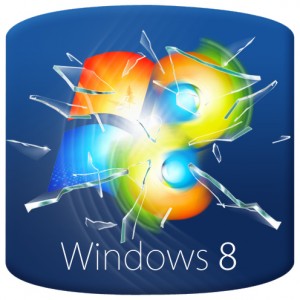A touch-friendly Windows 8 is least of Microsoft's tablet problems

Next month at Microsoft's Build conference, the company is expected to release a public beta for its flagship OS – Windows 8. The event will be closely looked at given how little is known about the next version of Windows.
The interest around Windows 8 is largely due to it being Microsoft’s definitive competitor to iOS-based iPads. Apple decided to have the same mobile OS for their phones and tablets; Microsoft’s strategy is fundamentally different. Because they can, Microsoft rethought their desktop OS interface for the tablet form factor. Contrary to vocal belief, the strategy has merit – the enterprise. Being able to switch between a desktop (designed for the cursor) that offers legacy support and an intuitive touch interface is theoretically a boon, not a curse.
Microsoft’s Ribbon interface (introduced with Office 2007) and Windows Phone 7’s highly praised Metro UI come together in Windows 8. (Ribbon clubs toolbar options and in some cases offers finger friendly usability.) The interface will not be Microsoft’s problem for tablets and Windows 8. There is a strong push towards new web development technologies (HTML5, JavaScript) in both Windows 8 and Office 15, which leads me to believe applications will not be as much of a hassle either. (The expected Windows App Store helps.)
With the interface in place and applications expected, Microsoft is still in a fix. Their Achilles heel is the OEM ecosystem. A few weeks ago I was searching for a new laptop. I focused on PCs rather than Macs because PCs offered a better Back-to-School deal. After spending time on the online stores for HP, Dell, Samsung, Sony, Amazon, and Microsoft, I was ready to give up. All I wanted was a light-weight laptop with long battery life and an SSD at a reasonable price. I went to Apple’s website and I knew the MacBook Air was their product for my requirement. There were just two options for the 13” MacBook Air -- unlike HP, Dell or Sony, who don’t have any such product in the $1,300 price range.
Navigating the websites to compare the specs was frustrating and this led me to realize that one of the reasons why Macs sell is because they are easy to buy. This has nothing to do with whether they are better PCs or not. Apple has limited options and for some reason they fit into all general requirements. To my surprise, the 13” MacBook Air base model is $300 cheaper than the Samsung Series 9. That was the deal maker. My decision was made.
Outdoing a mobile OS like iOS or Android for a desktop OS is an engineering challenge and Microsoft’s efforts will be known once the Windows 8 tablets are ready. Legacy support comes at the cost of battery life. I wouldn’t bet on Windows 8 trumping iOS and Android in battery life. In case of Android tablets, we hear the wives totally dig the dual core Tegras! (Windows 8 tablet ads will unfortunately be on the same lines.) Unlike the PC market where Windows was an easier choice for home PCs compared to Linux; for tablets, Android is a compelling offering.
It is not the hardware specifications that will influence tablet decisions. Whether it has one USB port or two won’t be the first question. How light is it, how long does the battery last, how touch friendly and cloud-powered the software is – these are the primary decision makers. Claiming Flash or Office 2010 compatibility while having a battery life less than the iPad, will not sell Windows 8 tablets.
Microsoft is expected to implement lessons it learned with Windows Phone 7 and have fixed chassis specs for tablets. These chassis specs coupled with OEM hardware differentiation such as Memory Card Readers, camera megapixels, RAM and CPU cores will only add to a buyer’s dilemma. The result is, as in my case while searching for a new laptop, most people will go for the option that’s less complicated (and more of a segment benchmark).
Windows 7 is expected to be on 42% of the PCs by year-end. Convincing companies to upgrade to a new OS next year will be a tough sell. Steven Sinofsky’s assurance that Windows 8 will support Windows 7 hardware helps Microsoft avoid the enterprise hardware refresh cycle trap, though I don’t see the enterprise jumping onto Windows 8.
A touch friendly OS isn’t exactly Microsoft’s biggest problem when it comes to Windows 8. Selling them to the end-user is and that is a whole different ball game. Sinofsky and Ballmer have bigger problems. I do not consider iPads to be post-PC devices; they have limited PC functionality and an improved touch interface.
Considering iPads as PCs, Apple is the second largest OEM. The OEM partners should feel threatened. Two iterations of the same product have made Apple the second largest OEM player ahead of Dell, Lenovo and others. According to figures, Android based tablets are expected to grow by 134% and the iPad saw a slight decline in sales. These statistics show an opening for non-iPad users, but if Microsoft can’t get the battery life right and delivers a delusional marketing message, Redmond will only be playing catch-up.
See also:
- Why consumers won't buy tablets (unless they're iPads)
- Microsoft Windows boss shares more hints on Windows 8 features
- Lenovo strategy pays off, remains upbeat on outlook and tablet plans
- Where does my MacBook Air leave my tablets? Or my MacBook Pro, for that matter?
- Gartner: Apple gains as PC sales fall in Europe
- Staples: Tablet prices will fall through year, but inventory risk minimal
- HP's TouchPad launch, inventory under the microscope